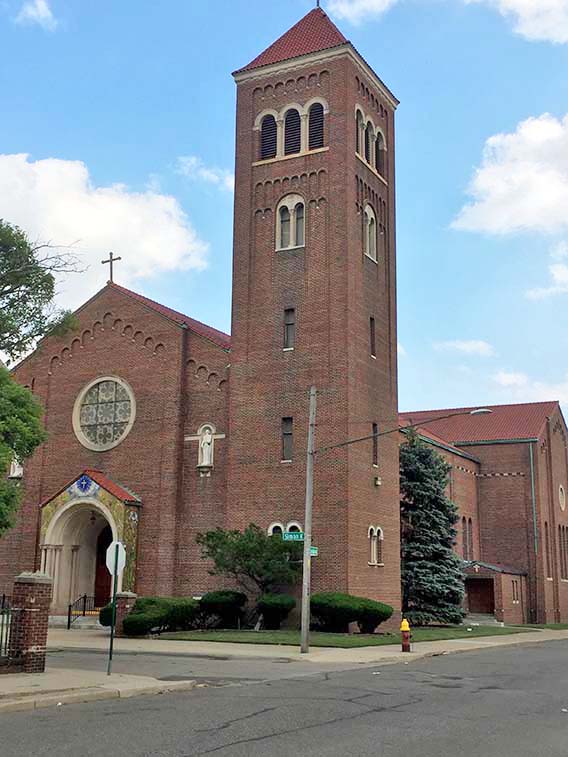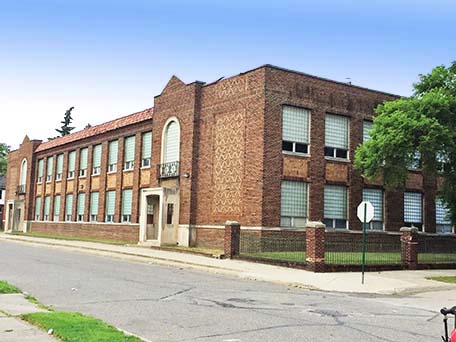

This parish was organized in 1925 to serve, I believe, a rapidly-growing Polish population that migrated into this neighborhood. Many of the men, I presume, were employed at Ford’s nearby plant in Hamtramck and at the Dodge Main nearby in Detroit. I do not know who designed this impressive church and I have not been inside the structure. I have read— and seen pictures—demonstrating that it has one of the most elaborate and extensive collection of religious mosaics to be found in the Detroit area. Apparently, the most striking attribute of this church is the interior with its colorful and detailed mosaics.
The catchment area of the parish lost population rapidly in the decades following 1960 as the older Polish population moved away or died and no new immigrant stream arrived from Poland to replace them. And the Ford and Dodge plants ceased assembling vehicles. In 2006, Transfiguration parish was merged with Our Lady Help of Christians (12635 McDougall, Detroit), a parish founded in 1923. The combined parishes used both names.
In 2012, there was a further consolidation when St. Ladislaus parish in Hamtramck (2730 Caniff) and St. Louis the King parish (18,891 St. Louis in Detroit) were merged with Transfiguration/Our Lady Help of Christians. The new parish was named Blessed John Paul II parish. While this is a combined parish, I believe that weekend Masses are said in Transformation, St. Louis the King and St. Ladislaus churches. In other words, the staffing has been reduced but three large churches must be maintained. I wonder how long that will continue? There is a clear reason why no weekend Masses are said in the former Our Lady Help of Christians church. After the Detroit dioceses merged the parish, the diocese sold the five buildings on the campus for use as an Islamic Center or Masjid Alfalah, namely the Islamic Center of North Detroit.
Few immigrants have migrated to Detroit in recent decades but there has been a surprising and unexpected movement to the city of people from Bangladesh. The Census Bureau’s 2016 survey enumerated about 15,000 Bengalis in metropolitan Detroit. There are so many living in this area along the Detroit-Hamtramck border that it has become known as Banglatown.
The transformation of Christ is described in the gospels of Luke, Mark, Matthew and is alluded to in the second epistle of St. Peter. To keep the story short; Jesus, Peter, James and John went to a mountain, later called the Mount of Transfiguration, to pray. On the mountain, Jesus began to shine with bright rays of light. Then the prophets Moses and Elijah appeared next to Jesus and he spoke with them. Jesus was then called "Son" by a voice in the sky, assumed to be God the Father. You might also wonder why the church shown above is located on Simon K. Street. Father Simon Kilar was the founding priest for the parish so the street carries his name.
Transfiguration parish once maintained a large parochial school, but it closed. In the spring of 2017, the archdiocese of Detroit and the City of Detroit’s Housing Department requested that developers bid on purchasing the building. The 21,500-square-foot property, built in 1925, was promoted as being suitable for conversion into 15 to 25 mixed-income units. In the fall of 2017, the city and archdiocese announced that the school was transfe rred to a non-profit housing development corporation. They intend to spend $6.4 million dollars to convert the building into 23 residential units for moderate-income residents with monthly rents of $500 to $600. One might assume that some of the residents will be members of the community. To help stabilize the neighborhood, 18 nearby abandoned homes will be razed by the city. This investment in a former Catholic and its environs in Benglatown neighborhood of Detroit helps to dispel the widely held notion that substantial financial investments in Detroit are being made only in Downtown, Midtown or along the east river front.
rred to a non-profit housing development corporation. They intend to spend $6.4 million dollars to convert the building into 23 residential units for moderate-income residents with monthly rents of $500 to $600. One might assume that some of the residents will be members of the community. To help stabilize the neighborhood, 18 nearby abandoned homes will be razed by the city. This investment in a former Catholic and its environs in Benglatown neighborhood of Detroit helps to dispel the widely held notion that substantial financial investments in Detroit are being made only in Downtown, Midtown or along the east river front.
Architect for the church: Unknown to me
Date of construction: 1949
Website for Blessed John Paul II parish: http://www.gcatholic.org/churches/usa-06/20073.htm
Website for developer: http://ethosdp.com/about-us/
Use in 2017: The church remains in use. The school may be converted into housing.
City of Detroit Designated Historic District: Not listed
State of Michigan Registry of Historic Sites: Not listed
National Register of Historic Places: Not listed
Photograph: Ren Farley; July, 2018
Description prepared: November, 2018